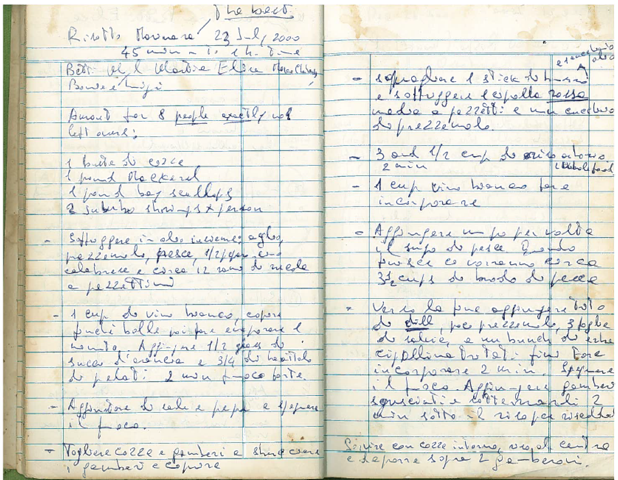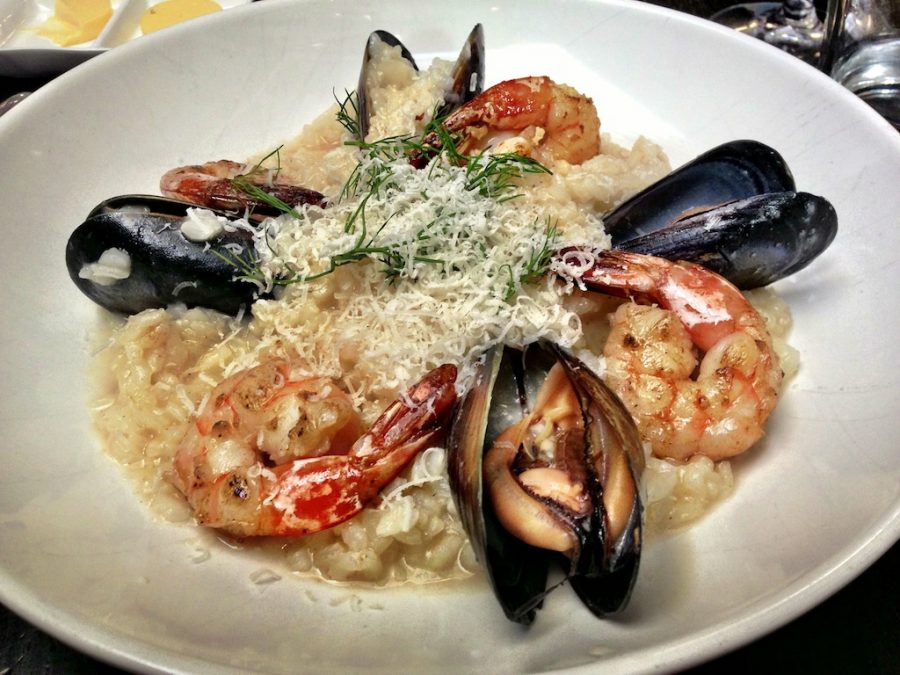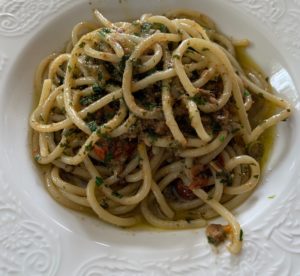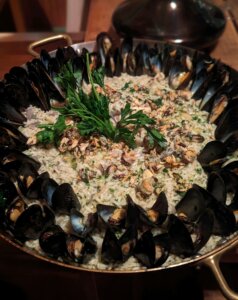(For 8 people)
A long time ago, I started writing some of my favorite recipes into my “little green book,” a bound green notebook. My daughter, Martina, was just eleven years old at the time, and she liked rating my recipes with Betti. Anytime I prepared a new recipe, Betti, Martina, and any guest who happened to be there for the meal would provide a satisfaction rating, using a ten-point scale. Betti kept giving me 9s and 10s, but Martina made me work. I just looked through my book and found a recipe that even Martina thought was “the best.”

Ingredients
- 2 pounds mussels

- 1 pound mackerel
- 1 pound bay scallops
- 16 jumbo shrimp (2 per person)
- 2/3 cup of extra-virgin olive oil
- 3 garlic cloves, smashed
- ¼ cup freshly squeezed orange juice
- 1 and ½ cups white wine
- 1 handful of chopped Italian flat-leaf parsley
- 1 handful of fresh arugula
- 1 handful minced chives
- 1 handful minced fresh dill
- 3 leafs of fresh sage
- 1 medium red onion, finely chopped
- 1 spicy pepper, such as an Italian pepperoncino or a Thai pepper
- Salt and freshly grated black pepper to taste
- 3 and ½ cups of risotto, Campanile preferred
- 2 liters fish broth, brought to a low boil in a medium sized saucepan (this is incorporated in the risotto)
Preparation
- In a large heavy pan, add ½ cup olive oil, 2 cloves of smashed garlic, parsley, fish, shrimp, arugula and parsley. Turn the heat to high, 2-3 minutes covered, till the arugula “disappears” and the mussels open.
- Add 1 cup of white wine, cover until it boils, about 1 min. Remove cover, let wine evaporate 1 minute.
- Add ½ cup of freshly-squeezed orange juice and ¾ of a box of Pomì chopped tomatoes –or homemade canned tomatoes. Cook for 2 minutes on high heat.
- Add salt and pepper and turn off the fire.
- Remove all the seafood, placing it into a separately covered containerand peel the shrimp, leave the sauce in the pan in which you cooked the fish.
- Add ½ of cup olive oil to another pan.
- Add the chopped red onion, a handful of parsley, and a smashed garlic clove, and cook on low heat until the onion “starts” to become translucent.
- Add 3 and ½ cups of risotto and cook on high for 3 minutes, mixing constantly.
- Add 1 cup of wine, allow to evaporate for 1 minute.
- Add the fish sauce from the pan that you just cooked the fish —1 cup at a time—stirring continuously. Once you finish using all the just-cooked fish/sauce, start using the fish broth that you had warmed in the additional saucepan.
- As each cup becomes incorporated in the risotto, add the next cup.
- Near the end (just taste the rice, and when it is almost done but still a little harder than what you prefer) add the dill, a little parsley, 3 leaves of fresh sage minced, and a handful of minced chives. Mix into the risotto. Allow it to incorporate for 2 minutes. Turn off the fire.
- Add back the reserved fish and shrimp, gently mixing them into the risotto, which will warm up the fish.
- Plate the risotto, then arrange the mussels in an attractive pattern on the plate. (I like to create a circle of mussels around the risotto).
- Sprinkle freshly chopped parsley over each plate and serve immediately. Buon Appetito!
Italiano: Risotto alla Marinara
Molto tempo fa, ho iniziato a scrivere alcune delle mie ricette preferite in un taccuino verde rilegato. Mia figlia Martina aveva solo undici anni all’epoca e le piaceva valutare le mie ricette con Betti. Ogni volta che preparavo una nuova ricetta, Betti, Martina e qualsiasi ospite che si trovava lì davano un punteggio utilizzando una scala di dieci punti. Betti continuava a darmi 9 e 10, ma Martina mi ha fatto lavorare. Ho appena sfogliato il mio libro e ho trovato una ricetta che anche Martina pensava fosse “la migliore”.
Ingredienti per 6-8 persone
- 1 Kg di cozze
- 250 g kg di filetto di sgombro o altro pesce fresco senza spine!
- 250 g di capesante (muscoli)
- 16 gamberi (2 a testa)
- 160 ml di olio extravergine di oliva
- 3 spicchi d’aglio, schiacciati
- 60 ml di succo d’arancia appena spremuto
- 355 ml di vino bianco
- 1 manciata di prezzemolo tritato italiano a foglia piatta
- 1 manciata di rucola fresca
- 1 manciata di erba cipollina tritata
- 1 manciata di aneto fresco tritato (se non lo avete va bene uguale)
- 3 foglie di salvia fresca
- 1 cipolla rossa media, tritata finemente
- 1-2 peperoncini piccanti calabresi o di altra specie
- 500 g polpa di pomodori fatti in casa o comprati (Pomi` e simili)
- Sale e pepe nero grattugiato fresco a piacere
- Risotto circa 80-90 grammi a testa, cioe` per 6-8 persone circa 700g
- 2 litri di brodo di pesce, portato a ebollizione in una casseruola di media grandezza (questo va incorporato nel risotto)
Preparazione
- In una padella larga, aggiungere l’olio d’oliva, 2 spicchi d’aglio schiacciato, il prezzemolo, il pesce, i gamberi, la rucola e il prezzemolo. Alzate la fiamma, coprite 2-3 minuti, finché la rucola “scompare” e le cozze si aprono.
- Aggiungere 1 cup di vino bianco, coprire fino a quando bolle, circa 1 min. Togliere il coperchio, lasciare evaporare il vino 1 minuto.
- Aggiungere 60 ml (1/2 cup) di succo d’arancia appena spremuto e ¾ di una scatola di pomodori Pomì a pezzetti (500 g). Cuocere per soli 2 minuti a fuoco forte.
- Salate e pepate e spegnete il fuoco.
- Rimuovere tutti i frutti di mare, mettendoli in un contenitore coperto separatamente. Pelate i gamberi. Lasciate naturalmente il sugo nella pentola dove avete cucinato il pesce e coprite cosi` non evapora.
- Aggiungere 60 ml di olio d’oliva in un’altra padella dove cucinerete il risotto
- Quando l’olio e` caldo ma non troppo, aggiungere la cipolla rossa tritata, una manciata di prezzemolo e uno spicchio d’aglio schiacciato e cuocere a fuoco basso finché la cipolla comincia a diventare traslucida. Alzare il fuoco al Massimo.
- Aggiungete circa 700 g di risotto e cuocere a fuoco alto per circa 3 minuti, girando continuamente.
- Aggiungere 60 ml di vino e lasciare evaporare per 1 minuto.
- Aggiungere il sugo di pesce dalla padella in cui avete appena cotto il pescecon l’arancia e il pomodoro, una mestolo alla volta, mescolando continuamente. Una volta finite, continuate con il brodo di pesce che avevi riscaldato in una terza pentola.
- Man mano che ilbrodo viene incorporato nel risotto, aggiungetene un altro mestolo.
- Verso la fine (assaggiate il riso, e quando sarà quasi cotto ma ancora un po’ più duro di quello che preferite) aggiungete l’aneto, un po’ di prezzemolo, 3 foglie di salvia fresca tritata e una manciata di erba cipollina tritata. Mescolare nel risotto. Lascialo incorporare per 2 minuti. Spegni il fuoco.
- Aggiungere nuovamente il pesce e i gamberi messi da parte, mescolandoli delicatamente al risotto, che cosi` scalderà il pesce.
- Impiattare il risotto, quindi disporre le cozze in un disegno attraente sul piatto. (Mi piace creare un cerchio di cozze attorno al risotto).
- Cospargere di prezzemolo tritato fresco su ogni piatto e servire immediatamente.
- Buon Appetito!














